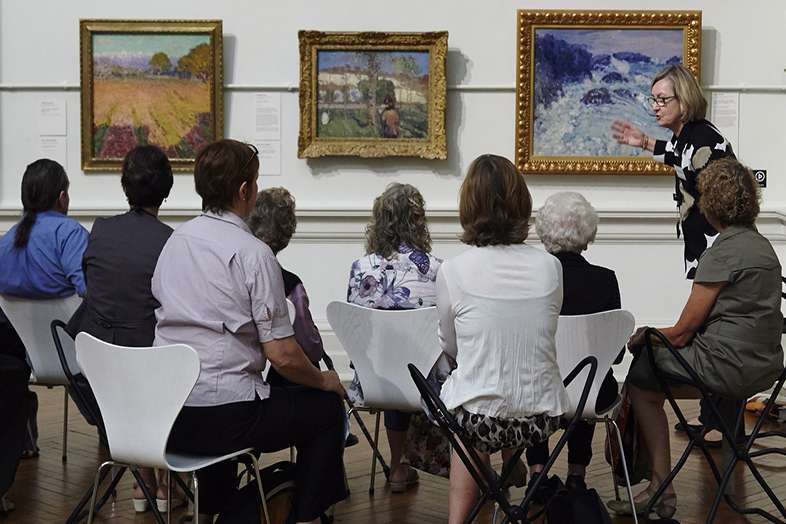Lessening the isolation of Alzheimer's

A small group of art lovers is seated in front of Frederick McCubbin's painting On the Wallaby Track, at the Art Gallery of NSW (AGNSW). Discussion roams freely as viewers ponder details of the 1896 oil – the woman seated on the ground leaning against a tree, the man stoking a small fire to boil a billy, the chubby baby lying across its mother's lap.
As a specially trained volunteer guides the viewers, small details spark conversations that reach back in time and provoke vivid recollections. The group comprises six people with dementia and one carer from a day centre in south-west Sydney who are taking part in the gallery's Art and Dementia program.
The theme is Adventures through the Australian Landscape. As well as the McCubbin, the group views Hans Heysen's The Coming Home (1904) and Eugene von Guérard's Waterfall, Strath Creek (1862).
At each work, the guide frames discussion topics, points out certain elements and poses questions – the smells of the bush, the time of day, the chubby baby, and how they got him there with no pram.
Danielle Gullotta, access co-ordinator at the gallery, first ran the program as a pilot in 2010, taking inspiration from Meet Me at MoMA, which ran for several years at the Museum of Modern Art in New York for people in the early stage of dementia, and their caregivers.
"[It was a time when] there was increasing awareness around art and health in Australia," says Gullotta. "The community demand was building – from occupational therapists, art therapists, carers working in community centres and in nursing homes."
This year, the gallery announced an expansion of the program, with funding from principal partner State Street. As well as hosting visits to the gallery, AGNSW will take the program to community organisations for people with dementia who are unable to travel.
For Gullotta, the benefits of the program can be catalogued as the bus departs with the latest group – social inclusion, intellectual and emotional stimulation, evocative experiences for people with dementia, new talking points for caregivers – but a formal examination of the program is now under way.
Dr Gail Kenning, of the Faculty of Arts and Social Sciences at the University of Technology, Sydney (UTS), has been commissioned by the gallery to evaluate arts engagement for people with dementia. She will look at the number and frequency of visitors but also the individual and his or her response to the art.
Dr Kenning says there is a growing acknowledgement of non-medical approaches to health, and the art and dementia program is a neat fit for study in that area. Her data will draw on clinical and medical experts in dementia, as well as people with dementia and their families, friends and caregivers.
"Anybody who's involved in the arts knows the importance of arts in day-to-day life. You experience art works," she says.
"Often when we look at people with different abilities, or ageing, or with health issues, as soon as you put arts into the equation, we start thinking about it as art therapy … what we're trying to think about is, not all art is art therapy. It's sometimes just about the experience of living.
"It's allowing people to have conversations about the art work, thinking about things that are stimulated by the art work."
John Watkins, the chief executive of Alzheimer's Australia NSW, says programs such as the one at the gallery are "all about ensuring people living with dementia are able to remain connected and included with their community".
Certainly that was the experience at MoMA. Research conducted by New York University, in partnership with the gallery, found the Meet Me at MoMA program provided an accepting and stimulating environment that aided a sense of inclusion among participants.
Watkins says: "Too often we hear that once people get a diagnosis of dementia, they feel isolated and unable to continue to go about their lives as they once had, due to lack of general awareness and stigma around the condition."
Dr Kenning says the conversation around dementia is frequently "about the lacks, the loss, the limitations … we're part of research into the potential that ageing, dementia, disability or perceived disabilities [can have] … about changing perceptions.
"We're not going to cure [people with dementia]. We're not going to make people better. What we're really interested in, and what the gallery is interested in, is that in-the-moment joy, that in-the-moment pleasure … things that we all experience."















